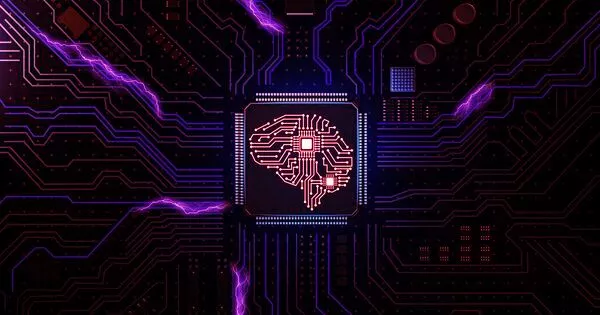Sandia National Laboratories researchers have demonstrated that neuromorphic computers, which synthetically replicate the brain’s logic, can solve more complex problems than artificial intelligence and may even earn a place in high-performance computing with the addition of a little math.
Random walk neuromorphic simulations can track X-rays passing through bone and soft tissue, disease spreading through a population, information flowing through social networks, and financial market movements.
According to Sandia theoretical neuroscientist and lead researcher James Bradley Aimone, the findings, detailed in a recent article in the journal Nature Electronics, show that neuromorphic simulations using the statistical method known as random walks can track X-rays passing through bone and soft tissue, disease passing through a population, information flowing through social networks, and financial market movements, among other uses.
“Essentially, we have demonstrated that neuromorphic hardware can yield computational advantages relevant to many applications, not just artificial intelligence, which it is obviously related to,” Aimone explained. “New applications include radiation transport and molecular simulations, as well as computational finance, biology modeling, and particle physics.”
Neuromorphic computers, he claims, will solve problems faster and use less energy than traditional computers in optimal cases. The audacious claims should pique the interest of the high-performance computing community, according to Aimone, because finding capabilities to solve statistical problems is becoming increasingly important.
This neural net uses less energy overall than ordinary computing, which must record every step of every walk. This helps to explain the neuromorphic process’s speed and efficiency.
James Bradley Aimone
“These problems aren’t really well-suited for GPUs [graphics processing units], which are likely to be used in future exascale systems,” Aimone said. “What’s exciting is that no one has ever looked at neuromorphic computing for these kinds of applications.”
Brian Franke, a Sandia engineer and paper author, stated, “Because of the inherent randomness of the processes you list, they will be inefficient when directly mapped onto vector processors such as GPUs in next-generation computational efforts. Meanwhile, neuromorphic architectures are an intriguing and radically different alternative for particle simulation, with the potential to lead to a scalable and energy-efficient approach to solving problems of interest to us.”
Franke simulates photon and electron radiation to better understand its effects on components.
The team used the 50-million-chip Loihi platform, which Sandia received about a year and a half ago from Intel Corp., to successfully model random walks of gaseous molecules diffusing through a barrier, a basic chemistry problem. “Then we showed that our algorithm can be extended to more sophisticated diffusion processes useful in a range of applications.”
The claims are not meant to challenge the primacy of standard computing methods used to run utilities, desktops and phones. “There are, however, areas in which the combination of computing speed and lower energy costs may make neuromorphic computing the ultimately desirable choice,” he said.

Unlike adding qubits to quantum computers, which is another intriguing method of moving beyond the limitations of conventional computing, chips containing artificial neurons are inexpensive and simple to install, according to Aimone.
Moving data on or off the neurochip processor can still be expensive. “As you collect more, the system slows down, and eventually it won’t run at all,” said William Severa, a Sandia mathematician, and paper author. “However, we overcame this by configuring a small group of neurons to compute summary statistics, and we output those summaries rather than the raw data.”
Severa wrote several of the experiment’s algorithms.
Neuromorphic computing, like the brain, works by electrifying small pin-like structures and adding tiny charges emitted by surrounding sensors until a certain electrical level is reached. The pin then flashes a tiny electrical burst, similar to a biological neuron, an action known as spiking. In contrast to the metronomic regularity with which information is passed along in conventional computers, the artificial neurons of neuromorphic computing flash irregularly, as biological neurons do in the brain, and thus may take longer to transmit information, according to Aimone. However, because the process only depletes energies from sensors and neurons when they contribute data, it requires less energy than formal computing, which must poll every processor whether or not they are contributing.
Another advantage of the conceptually bio-based process is that it’s computing and memory components exist in the same structure, whereas conventional computing consumes energy by distant transfer between these two functions. The artificial neurons’ slow reaction time may initially slow down their solutions, but as the number of neurons increases, more information is available in the same time period to be totaled, according to Aimone.
The procedure begins with the use of a Markov chain, which is a mathematical construct in which, similar to a Monopoly gameboard, the next outcome is determined solely by the current state and not by the history of all previous states. This randomness contrasts with most linked events, according to Darby Smith, a Sandia mathematician, and paper author. For example, he said, the number of days a patient must remain in the hospital is at least partially determined by the preceding length of stay.
Beginning with the Markov random basis, the researchers used Monte Carlo simulations, a fundamental computational tool, to run a series of random walks that attempt to cover as many routes as possible. “Monte Carlo algorithms are a natural solution method for radiation transport problems,” said Franke. “Particles are simulated in a process that mirrors the physical process.”
An artificial neuron reading the results of each walk-in turn recorded the energy of each walk as a single energy spike. “This neural net uses less energy overall than ordinary computing, which must record every step of every walk. This helps to explain the neuromorphic process’s speed and efficiency” Aimone stated. More chips, he claims, will help the process move faster while using the same amount of energy.
According to Sandia researcher Craig Vineyard, the next version of Loihi will increase its current chip scale from 128,000 neurons per chip to up to one million. On a larger scale, multiple chips are combined to form a board.





